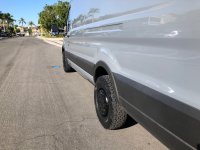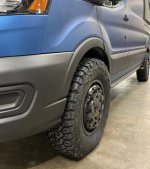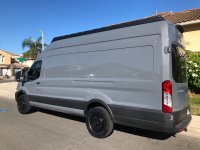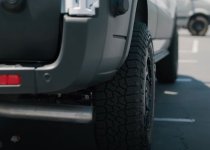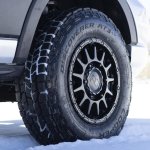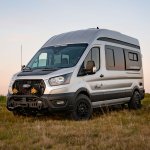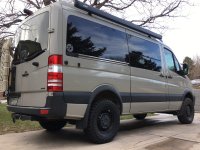Active member on the Transit USA forums, but I figure I might get better insight over here from more off-road oriented folks.
I'm currently building a 2020 High Roof, Extended Length, AWD, Ford Transit Camper Build.
I'm currently trying to decide if I want to put the absolute biggest tire that can be stuffed in the wheel wells without rubbing (for the most part), or go slightly smaller. I have put pretty much all the off-road upgrades I can on my van.
I currently run LT245/75R16 (9.5x30.5") Falken Wildpeak AT3W Tires on the Stock Steel 6.5", 98mm offset Ford Wheels. I want to upgrade the wheels to better support the tire sidewalls, gain stability from increase in vehicle width, add durability, and increase tire bead retention at low PSI (stock bead channel is not nearly as good as the Owl and Black Rhino Wheels), and better protect the face of the wheel and the wheel studs (studs currently stick out 27mm past the tire sidewalls on a stock wheel and 245/75r16 tires)
Basically, the biggest tire you can really squeeze into the wheel wells on a 2" Lifted AWD Transit, while still not rubbing through steering range of motion and suspension compression, is 31.9x10.7" when you have a slightly lower offset wheels than stock. 80mm is probably the sweet spot. It's still very tight, I'm guessing ~.5-.7" of clearance when turning after a lot of trimming, and you can't run splash guards.
The lower offset you go, the less clearance you have to the pinch weld (which must be folded over flat) at the rear of the wheel wells, so with a 60mm offset like the Black Rhino Sequoia Wheel, you have to go down in tire width and height to clear the pinch when turning. All the setups in the table below should work with only folding the pinch weld over and cutting plastic off the front bumper. More clearance overall with the 30.5" Tires.
The benefit of the taller tires is of course more ground clearance overall. The rear differential skidplate sits a lowly 7" off the ground with the 245/75r16 tires, so I could gain .7" all around going to the bigger tires. Of course the downsides are:
-Lower mpg (larger 17" tire/wheel combo weighs 10lbs more than the 16" combo)
-More stress on the drivetrain and worse accel (I may consider re-gearing to 4.10 in the rear with a truetrac diff eventually)
-Very little space for mud and snow/ice buildup
-Possibly a little bit of rubbing at extreme articulation angles
-Wheel face and lug studs/nuts are considerably more exposed to damage on the 80mm offset wheel.
So the question is - is the extra .7" of ground clearance worth the downsides? Would you stuff the biggest tire in there that can realistically fit, or go slightly smaller for the extra benefits and breathing room that brings?
Most off-road trucks and vehicles and even sprinters have much larger wheel wells to allow for some space between the tire and wheel during all circumstances. If only Ford had just added a couple of inches to the front wheel wells...

~30.5" Tire in Transit Wheel Wells:
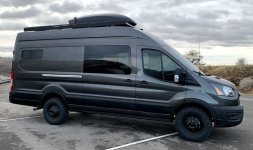
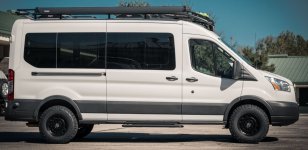
My Van currently with 245/75R/16 (sitting higher in travel now than it eventually will). Plastic front bumper, Plastic in front of rear wheel, and front splashguard can be trimmed/removed to give .7" more space)
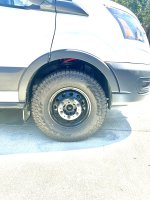
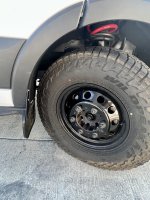

_____________________________________________________________________________________________________________________________________
~31.7" Tires in Ford Transit Wheel Wells:
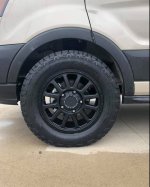
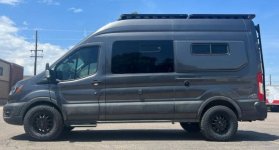
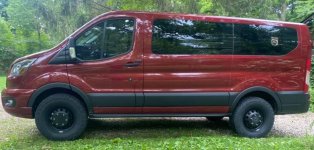
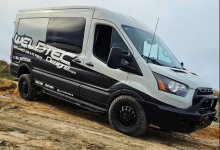
I'm currently building a 2020 High Roof, Extended Length, AWD, Ford Transit Camper Build.
I'm currently trying to decide if I want to put the absolute biggest tire that can be stuffed in the wheel wells without rubbing (for the most part), or go slightly smaller. I have put pretty much all the off-road upgrades I can on my van.
I currently run LT245/75R16 (9.5x30.5") Falken Wildpeak AT3W Tires on the Stock Steel 6.5", 98mm offset Ford Wheels. I want to upgrade the wheels to better support the tire sidewalls, gain stability from increase in vehicle width, add durability, and increase tire bead retention at low PSI (stock bead channel is not nearly as good as the Owl and Black Rhino Wheels), and better protect the face of the wheel and the wheel studs (studs currently stick out 27mm past the tire sidewalls on a stock wheel and 245/75r16 tires)
Basically, the biggest tire you can really squeeze into the wheel wells on a 2" Lifted AWD Transit, while still not rubbing through steering range of motion and suspension compression, is 31.9x10.7" when you have a slightly lower offset wheels than stock. 80mm is probably the sweet spot. It's still very tight, I'm guessing ~.5-.7" of clearance when turning after a lot of trimming, and you can't run splash guards.
The lower offset you go, the less clearance you have to the pinch weld (which must be folded over flat) at the rear of the wheel wells, so with a 60mm offset like the Black Rhino Sequoia Wheel, you have to go down in tire width and height to clear the pinch when turning. All the setups in the table below should work with only folding the pinch weld over and cutting plastic off the front bumper. More clearance overall with the 30.5" Tires.
The benefit of the taller tires is of course more ground clearance overall. The rear differential skidplate sits a lowly 7" off the ground with the 245/75r16 tires, so I could gain .7" all around going to the bigger tires. Of course the downsides are:
-Lower mpg (larger 17" tire/wheel combo weighs 10lbs more than the 16" combo)
-More stress on the drivetrain and worse accel (I may consider re-gearing to 4.10 in the rear with a truetrac diff eventually)
-Very little space for mud and snow/ice buildup
-Possibly a little bit of rubbing at extreme articulation angles
-Wheel face and lug studs/nuts are considerably more exposed to damage on the 80mm offset wheel.
So the question is - is the extra .7" of ground clearance worth the downsides? Would you stuff the biggest tire in there that can realistically fit, or go slightly smaller for the extra benefits and breathing room that brings?
Most off-road trucks and vehicles and even sprinters have much larger wheel wells to allow for some space between the tire and wheel during all circumstances. If only Ford had just added a couple of inches to the front wheel wells...

~30.5" Tire in Transit Wheel Wells:


My Van currently with 245/75R/16 (sitting higher in travel now than it eventually will). Plastic front bumper, Plastic in front of rear wheel, and front splashguard can be trimmed/removed to give .7" more space)



_____________________________________________________________________________________________________________________________________
~31.7" Tires in Ford Transit Wheel Wells:




Last edited:

